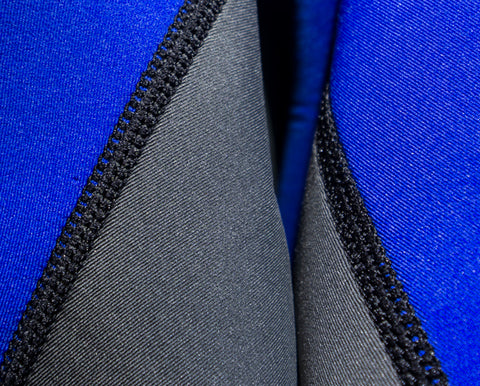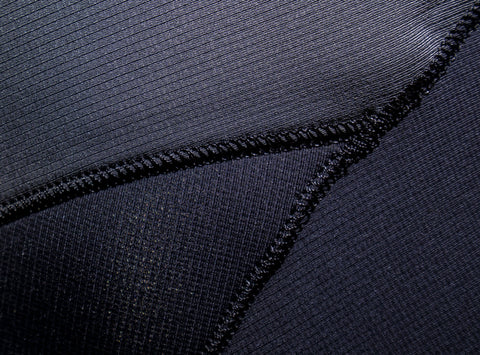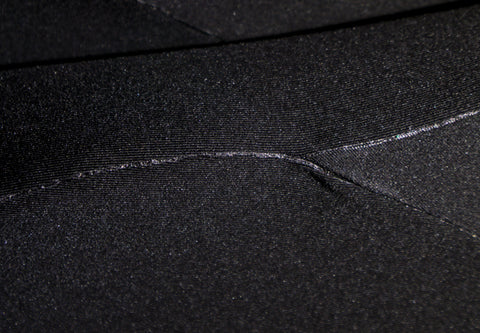Wetsuit Stitching: There seams to be more to it
August 18, 2021 6 min read

Wetsuit Seams and their stitching are often overlooked but certainly the most important aspect of a surfing wetsuit is the seam as it's the major factor in warmth, stretch and comfort: the three main types being Flatlock, Glued and Blindstitch [GBS] and Taped/Welded.
This blog is set to give you all the relevant wetsuit stitch and seam information for you to make an informed decision. The neoprene itself is definitely the main element to a wetsuit and it's quality is measured by the level of stretch. The variation between neoprene types has an affect on everything but in terms of warmth there is little difference for a given thickness. Conversely a seam can have a massive impact as seam type decides wether the suit lets in water or not and this is a BIG DEAL. A suit’s ability to keep you warm is decided by the seam and a good seam can get you out in the water all year round and for longer sessions, that’s why we wear a wetty, right?
It’s easy to point to the thickness of the neoprene as the defining factor in terms of warmth but neoprene is simply an insulator, to insulate effectively you need a sealed environment.. if you leave the windows open your heater isn’t going to work, it's just going to blow hot air outside. This very notion demonstrates the relationship between a wetsuit’s neoprene with it’s seam and that you don't necessarily need to go thicker if you're after more warmth.
What is the difference between wetsuit Seams and Stitches?
In today’s world of surfing wetsuits you’ll find four seams with vastly different names/trademarks for those four, well more so 3 and an asterisk: Flatlock, Glued and Blind-Stitched [GBS] and Taped seams*. Instead of telling you what seam is best, for surfing etc, because it's not that simple. I'd like to run through the most important aspects of a seam and how each seam performs.
For me, the most important factor of a seam is its ability to keep cold water out and warm water in. We wear a wetsuit to keep warm and the seam contributes to warmth more than any other element. Without diving too deep into thermodynamics, because I can't, a suit is most effective when it’s completely dry on the inside but this is practically impossible when you’re dealing with full submersion and a wave’s turbulent water but you definitely don’t want to surf in a dry-suit.. Alas, our only hope is to minimise this movement of water in and out of the suit, or most ideally, seal in a small volume of water which your body-heat warms, in turn, providing three mediums of insulation: the trapped water, the neoprene itself and fat.
The Flatlock Stitch - Durable, Cheap and Cheerful wetsuit seam.
Of the seams we’re discussing today the only that does not offer a true ‘seal’ is the Flatlock, which is most common as it’s quick to lay, durable and effective at keeping a suit in one piece. Sounds perfect but the downside is free passage for cold water to enter your suit. As a guide: entry-level wetsuits always use the Flatlock because it's cheap, easy and durable but you’ll struggle to find it in a suit over $250, on the other hand, you won’t find a sealed suit for less than $250 [except for the2017 Adreno Surf suits].

Flatlock Stitching: Entry level seam, allows water to enter through thousands of pinholes. but highly durable.
What is Flatlock stitch? A Flatlock stitch butts the two materials together and puts a mirrored stitch along both sides of the material, locking every loop [very durable, but minimal stretch capacity] This results in cold-water flushing every time you contort your body underwater because the body moves and contorts within the suit, creating low and hi pressure cavities.
Do I need a good wetsuit seam?
Picture your duck dive, especially the moment that you arch your back to trim towards the surface. This motion creates a big pocket of low pressure in your lumbar [next time you’re in a suit arch your back and feel your lumbar] which in turn sucks water through the seams around your lumbar [and the zip, but we’ll cover zips/enclosures later]. This is a problem because now your wetsuit is full of cold water and now that this water is in direct contact with the skin it's going to wick heat away from your body 25x faster than air… as a result, you’ll be shivering, bummed and keen to call quits on the session, which is crazy to me- why wear a wetsuit that isn’t going to extend your surf.
This is why I firmly believe that a surfing suit with a Flatlock is only for summer, regardless of the thickness [back to this house analogy: thick walls insulate, they don’t generate heat which is why an insulated house will stay colder {or hotter} for longer- do you want a wetty that works to keep you colder?!?!] besides, the thicker your suit the more resistance in paddling therefore you're working harder than in a thinner suit which will cut your sessions even shorter!!Glued and Blind-stitched [GBS] - High Performance
On the other arm you have a sealed suit, sealed suits are always stretchier, warmer and because they’re inherently warmer you can not only get away with wearing less rubber but you can enjoy a more flexible neoprene [flex/stretch is a result of adding nitrogen bubbles to the rubber, conversely this means less insulation {this is the reason wetsuits are so buoyant!!}] It’s like win-win-win..? A GBS seam is the minimum standard for a decently warm winter suit, you can run a 10mm flat lock but it’s just gonna let in cold water, making it marginally warmer than the surrounding water, where as a GBS 2mm will keep the water out and you warm….
What is a GBS seam/stitch?
The GBS is the most common of the seals and it’s the suit that your pros will use in contests: this is because they’re the most stretchy but don’t have the durability to stand up to daily bashings from top-level surfers. For the weekend warrior, the GBS is the best option because the seal is great, the stretch is immense and the price is agreeable. If you’re surfing more than 3 times a week it’s worth considering a ‘taped seam’ which i'll explain below. The GBS takes a hooked needle half-way into the neoprene, resulting in no pin-holes but requires glueing on the non-stitched side of the seam.

Blind Stitch: High performance seam, has greatest potential stretch and is used in Competition suits. Often reinforced with Glue [GBS] which also improves the seal.
The blind stitch is a loose stitch and has great expansion properties, hence the stretch, but a relatively un-spoken advantage to the blind-stitch is its ability to grow and contort to the body [like a stocking], making it the best option for kids because it will grow with them- which is VERY important because buying a suit that ‘they can grow into’ means they’re gonna be cold until they fit it…. more often than not this results in you buying a wetsuit they won’t wear until they’re older.. which is just as wasteful as buying a suit that they’ll grow out of.
The glued component of a Glued and Blind Stitched seam. As you can see: no pinholes from the sewing machine!

Taped Seams - Added Durability
The taped seam is usually an extension of the GBS seam in the sense that there’s an elastic tape running along the inside, or outside, of the suit’s seams- resulting in another level of seal and is generally the most durable kind of sealing. Being that the tape is generally the least stretch component of the seam it tends to bear the stress and strain of the body’s contortions and as a result, tends to be the widest seam. Often considered the best wetsuit seam because of the associated price it's important to consider it's benefits, namely durability.

Taped Seams: An elastic 'tape' is laid down over the existing seam to greatly increase seam durability and no pin-holes!
Welded Seams - Premium Performance
Welded seams work in the same fashion as a taped seam, running on the inside of a wetsuit's seams for added sealing and durability. The beauty of a welded seam is its ability to provide maximum stretch in a non-stitched design. This also gives the neoprene a clean, low profile. However, there will always be variability between manufacturers and individual suits. In some cases, seam welding will be used to reinforce a blind-stitch on the exterior of the suit. Nevertheless, with a welded seam effective water sealing is guaranteed.

Welded Seams: Glue is used to 'weld' neoprene panels together, forming a flexible and impermeable layer over seams.
Various brands have different names and slide modifications to the tape seam but typically the tape is applied over a GBS seam but in some top of the line suits, such as the O’Neill Fluid Seam which has no stitching at all, resulting in the most stretch and arguably the most durability.
Another handy bonus with the tape seams is that repairing and maintaining the seam is easy thanks to the durability of the tape itself- if the tape starts peeling off you can simply glue it back down with a neoprene glue [Picasso’s Neoprene is the glue we use and recommend] and you can be assured that there will be no water penetration or reduce durability of the seam itself- just make sure you suit is dry when you apply!
Photos and video shot in our Brisbane Store


